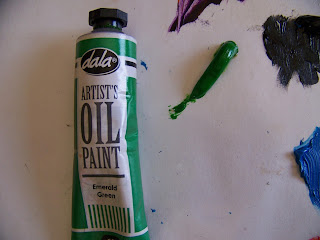I will be using three circular wooden canvasses for these paintings. As the surface has not been prepared to accept paint, I start by preparing it with a coating of gesso, which will help the paint to adhere to the surface.
In each case, the focal instrument will take center stage on the canvas and that is where I start. Do not aim for perfect drawings here as that is not the style in which we will be painting. Concentrate more on shape.
The strongest decorative element in the paintings will be the checkered sections and this needs to be put in place next. Do not aim for geometric accuracy as this will detract from the whimsical character of the paintings.
I will add three more design elements to the canvas and divide my canvas accordingly into sections to receive these.
I add some musical scores as a design element.
The next design element is a rhombus, which has strong connections to the carnival.
The last design element will simply be paint blotches.
For the second painting I once again start with the focal aspect; the piano bars.
I then start adding the design elements in the same sequence as before, but making sure they do not end up in the exact same places as before.
I finish off with the last of the design elements.
My warped saxophone again takes center stage on the canvas.
The design elements are again added as before.
I will be painting these scenes in oil colours and start with Titanium White. I will be using a small flat brush for the majority of the painting, but will point it out to you when I swap brushes.
I paint the white sections of the checkered patterns first on all three canvasses.
Here is a close-up view of the white being added.
I do not clean my brush when I go to the next colour but simply squeeze the colour from the brush onto a dry kitchen towel. This is done throughout the painting. I only clean the brush when I set the paintings aside to dry. I next use Lamp Black.
This is used to paint the black parts of the checkered sections.
I then squeeze out some Cerulean Blue onto my disposable palette.
The checkered sections are painted in this colour.
Now I want some vibrant Vermilion.
The sections reserved for the paint blotches are painted red.
I follow up with Dioxazine Purple. I seem to have neglected taking a photo here. What I did was to pick the paint up with a palette knife and to simply make a couple of random smears into the wet red.
I now want to add some Emerald Green.
This is used to fill in the areas with the musical scores.
I now return to Titanium White.
I paint the piano keyboard with this. Do not fret when you pull other colours into your newly laid down colours. This is the marvel of working ala prima; the controlled mixing of colours to blend into a perfect unity.
Now I want some Dacmium Deep Yellow.
This is used to paint the saxophone. Pay attention to the directional painting.
I now return to the Vermilion.
This is used to fill the hole in the guitar. Note that the hole falls across a Vermilion background in my painting.
Prussian Blue is added to my palette.
This colour is used to paint the guitar.
I then use the palette knife, turned onto it's sharp side, to sgraffito some lines into the wet paint, mimicking guitar strings. Refrain from accuracy!
I return to the yellow and this time I use the fine point on the front of my palette knife, picking up a little paint at the bottom of the knife point.
Four swift and small dabs with the palette knife creates the impression of the rhombus design. Do not overwork this, or you will loose the individuality of the yellow and end up with green when your colours mix.
Here is a close-up shot of what I did.
I again use the sharp side of the palette knife to scratch lines into the piano to create the individual bars.
I again dab only the point of the palette knife into the paint. This time I pick up the black paint.
I dab at the bars, dragging the palette knife only slightly down to create the black bars on the piano. Count carefully to mimic the piano accurately.
I then return to the yellow once more, but this time I mix the yellow equal parts with the white to get a slightly paler yellow.
This paler shade of yellow is used to add detail to the saxophone.
I again use the point of my palette knife to pick up some black.
I add the detail to the guitar head the same way I did the black keys on the piano.
I use the side of the palette knife dipped in black to scratch the music notes into the paint. The tip of the palette knife is used to make the round parts of the notes.
Time to sit back and survey the results critically.
I now grab a very fine round brush, dip it in black and paint my name as unobtrusively as possible on each of the canvasses.
This set of paintings are available in the Gallery under Miekie on APrettyTalent.com. Follow this link for easy navigation.
This set of paintings are available in the Gallery under Miekie on APrettyTalent.com. Follow this link for easy navigation.
For more crafty ideas and great products, visit APrettyTalent.com.
Remember to keep nurturing your TALENT for making PRETTY things.
You can subscribe to this blog and receive regular updates by email by simply registering your email address at the top of the current blog.
















































No comments:
Post a Comment